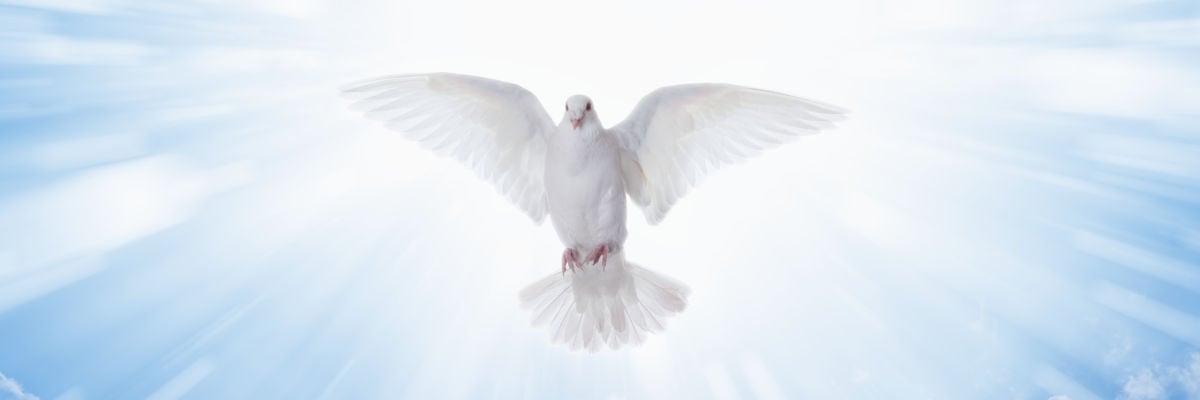
Homily for the Baptism of the Lord, Year C
The people were filled with expectation,
and all were asking in their hearts
whether John might be the Christ.
John answered them all, saying,
“I am baptizing you with water,
but one mightier than I is coming.
I am not worthy to loosen the thongs of his sandals.
He will baptize you with the Holy Spirit and fire.”
After all the people had been baptized
and Jesus also had been baptized and was praying,
heaven was opened and the Holy Spirit descended upon him
in bodily form like a dove.
And a voice came from heaven,
“You are my beloved Son;
with you I am well pleased.”
— Luke 3:15-16, 21-22
Why did the Holy Spirit appear as a dove at Our Savior’s baptism in the Jordan? Was it a real animal or only a figment? And, if real, what happened to the dove after this magnificent revelation of the Blessed Trinity, through the Father’s voice, the Son’s Incarnation, and the Holy Spirit’s hovering over the waters?
Now, someone might object that this is a very minor matter and that the answers to these questions might encourage mere quibbling, as in the old accusation against medieval scholastics asking, “How many angels can dance on the head of a pin?” (By the way, the answer is clear to anyone who has studied a bit of angelology: a potentially infinite number!)
But this is not quibbling, and asking these questions is a normal, natural result of taking the Gospel accounts of the mysteries of salvation seriously. The fact is that if God chose to reveal the highest of all mysteries—the Trinity and the Incarnation—by means of these manifestations, then they must be important, and meditating on their meaning must be a fruitful exercise.
In his Summa of theology, third book, question 39, articles 6 and 7, St. Thomas Aquinas asks how it was appropriate for the Holy Spirit to have descended on Christ in the form of a dove and whether the dove in which the Holy Spirit appeared was an actual animal. What was the meaning of his appearing thus? According to the Fathers, especially St. Augustine following St. Cyprian, the dove was a symbol of the unity of Christ’s members in one church; this is from the Song of Songs: one is my dove, my beloved. The Bridegroom of the Canticle mystically signifies Christ, who calls his beloved bride, the Church, with the pet name of “dove.” Thus, the grace of charity bestowed in baptism makes us all members of the one Christ in one body, the Church, and is appropriately signified by the descending dove.
The dove is also peace-loving, faithful to its spouse, prolific in offspring, and given to mourning. All of these pertain to the life of the Church on Earth as she awaits her final union with Christ the Bridegroom at the marriage banquet of heaven. Here we see how our God “projects” his qualities onto us by making the symbol of us, his members, a symbol of himself, a symbol of true unity in love.
But was this a real animal or only a kind of vision? St. Thomas, after some change of his opinion in the matter, came across a text of St. Augustine in which he teaches that the dove was indeed a real animal and not just a figment. He teaches that since the Holy Spirit is the spirit of truth, it would not be appropriate for him to reveal himself in his personal mission to us by a mere figment or imaginary vision, somewhat deceptively, as if a dream. Thus, he concludes that the dove was a real animal produced the by the power of God without any other doves, just as the body of the Savior was formed without human seed in the womb of his Holy Mother. Yet this dove did not become the Holy Spirit but rather was the place where the Spirit showed his presence.
Now, modern people may smile indulgently or even be a bit annoyed by such a descent to details, and their reaction might be, “Well, this is hardly an essential teaching of the Faith!” Yes, it is true that you can believe the dove was a real one or just a produced vision of one; there is not nor will there ever be a binding teaching on this point! The most important point to draw from St. Augustine and St. Thomas is that if God saw fit to place in his inspired word such details, then the loving heart of the believer will gratefully and diligently seek out their meaning.
This is the attitude of the great ages of our Faith. By accepting this attitude with an open heart, we will realize that it is the rationalists and the minimalists who are the quibblers, while those of robust, biblical, and apostolic faith will be content to contemplate the dove as he descends “with incandescent fire.”
As for the fate of this miraculous bird, perhaps that is a story for some imaginative Catholic storyteller to offer us! I offer my own theory. Just as the Savior is prefigured as the lamb of sacrifice, so too is he prefigured in the poor man’s dove of sacrifice. Perhaps this dove made her way to the temple and joined the other doves who were being offered there to prepare the way for Christ’s offering of his own body “in the eternal Spirit.”



